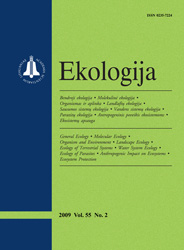 ISSN 0235-7224 ISSN 2029-0586 (online) |
2007 m. Nr. 1 Effects of 137Cs and 90Sr on the plant Lepidium
sativum L. growth peculiarities
The paper presents an estimation of 137Cs and 90Sr effects on the plant testorganism Lepidium sativum L. seed germination, root and shoot growth as well as on the change of parenchyma cell parameters under experimental laboratory conditions. All the 137Cs activity concentrations studied (4·102–4·105 Bq/l) have been found to induce a statistically significant slight stimulation of L. sativum root growth. From all 90Sr activity concentrations studied (1·103 – 2·105 Bq/l), only the highest activity concentration statistically significantly increased L. sativum root growth. All the other 90Sr activity concentrations statistically significantly slightly inhibited root growth. The effect of 4·104 Bq/l was most pronounced. All 137Cs activity concentrations studied demonstrated an insignificant stimulation of L. sativum shoot growth. The highest statistically significant stimulation level was observed at the 137Cs activity concentration of 4·104 Bq/l. Aqueous solutions containing separate 90Sr activity concentrations (1·103 – 3·104 Bq/l) also statistically significantly stimulated shoot growth, the stimulation being much more significant than in 137Cs aqueous solutions. The different effect of 137Cs and 90Sr on the growth of plant vegetative organs (roots and shoots) can be explained by the different metabolism of 137Cs and 90Sr as stable chemical analogues of K and Ca, respectively, in plant cells. This predetermines their variable accumulation in separate plant organs and their different distribution in plant cells and tissues. Keywords: technogenic radionuclides, concentration activity, plant test-organism, seeds, roots, seedlings, parenchyma cells |
Issues:
2011 - Vol.57 No. 1, No. 2 2010 - Vol.56 No. 1-2, No. 3-4 2009 - Vol.55 No. 1, No. 2, No. 3-4 2008 - Vol.54 No. 1, No. 2, No. 3, No. 4 2007 - Vol.53 No. 1, No. 2, No. 2.priedas, No. 3, No. 4 2006 No. 1, No. 2, No. 3, No. 4 2005 No. 1, No. 2, No. 3, No. 4 2004 No. 1, No. 2, No. 3, No. 4 2003 No. 1, No. 2, No. 3, No. 4 2002 No. 1, No. 2, No. 3, No. 4 2001 No. 1, No. 2, No. 3, No. 4 |